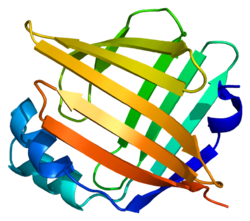Top Qs
Timeline
Chat
Perspective
FABP5
Protein-coding gene in the species Homo sapiens From Wikipedia, the free encyclopedia
Remove ads
Fatty acid-binding protein, epidermal is a protein that in humans is encoded by the FABP5 gene.[5][6]
Remove ads
Function
This gene encodes the fatty acid binding protein found in epidermal cells, and was first identified as being upregulated in psoriasis tissue. Fatty acid binding proteins are a family of small, highly conserved, cytoplasmic proteins that bind long-chain fatty acids and other hydrophobic ligands. It is thought that FABPs roles include fatty acid uptake, transport, and metabolism.[6]
The phytocannabinoids (THC and CBD) inhibit endocannabinoid anandamide (AEA) uptake by targeting FABP5, and competition for FABPs may in part or wholly explain the increased circulating levels of endocannabinoids reported after consumption of cannabinoids.[7] Results show that cannabinoids inhibit keratinocyte proliferation, and therefore support a potential role for cannabinoids in the treatment of psoriasis.[8]
Remove ads
Interactions
Inhibitors
References
Further reading
Wikiwand - on
Seamless Wikipedia browsing. On steroids.
Remove ads





